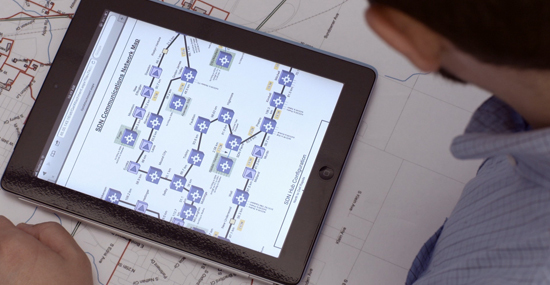
For most businesses, a time comes to reconsider connectivity options. A company might be expanding or relocating, for example. Or maybe its existing data-transmission network has gotten too slow, unreliable or insecure.
With advances in technology, networking options available to businesses are better than ever. They also can be confusing. Price, alone, shouldn’t govern important decisions about networking and a company’s long-range future, however. There’s too much at stake.
“The industry has become so cost-focused that the technology and secondary benefits sometimes are ignored,” says Jake VanDewater, director of network operations at SDN Communications.
Regardless of whether a business is looking for a basic link to the internet or needs a more complex network of private lines to securely connect multiple branch offices, the choice typically comes down to some kind of old-fashioned copper cabling vs. higher-grade fiber-optic cabling. Or, more simply, cable vs. fiber.
In most cases, when factors beyond cost are considered, fiber will prevail, VanDewater says.
1. Dedicated vs. Shared
The primary difference – and a major concern of customers – is the shared connectivity that cable solutions typically involve vs. the dedicated, more private connectivity that fiber offers clients, he says.
Installing, maintaining, serving, securing and monitoring fiber networks are specialties at SDN, the premier provider of broadband connectivity and other telecommunications services to businesses and institutions in the Sioux Falls region.
SDN’s competitors that specialize in cable solutions generally have one key advantage: their product is cheaper, at least in the short term. However, making good decisions about business networks often require long-range vision as well as short-term practicality because a good network could be used for decades.
2. Cost
Copper cable has been around longer than fiber. Typically, it’s readily available to businesses in most markets. Cable services, such as internet, cable TV and phone services, are often offered as bundled services.
For new customers, fiber often has to be installed, which raises the initial cost. Long-term, cost differences between cable and fiber might balance out. But the ubiquitous nature of copper lines – in the ground or hanging from poles – holds down the upfront cost of tying into cable.
Until fiber is more widely deployed, cable probably will enjoy a cost advantage. Fiber offers other advantages, though.
3. Reliability, 4. Capacity & 5. Speed
Generally, cable and fiber are both reliable. However, fiber service is less likely to be interrupted during power outages or electromagnetic interference because information is transmitted by light signals along glass conducting material rather than electrons.
Fiber typically has greater capacity, too, making service scalable and easier for growing businesses to expand.
As for speed, it’s no contest: fiber wins. Fiber networks allow users to send data over longer distances while maintaining a higher rate of speed. Dedicated lines also guarantee that the speed will be available when it’s needed, VanDewater says.
Network speed is actually a measurement of line capacity – 100 megabits per second, for example. Latency is a measurement of time. It reflects the millisecond delays in getting electronic information from one point to the other.
6. Symmetrical vs. Asymmetrical
Service on fiber is also symmetrical, meaning upload and download speeds are the same. That’s usually not the case with cable.
Most significantly, cable customers share bandwidth with others, so they're more likely to suffer delays or interference in transmitting data. If a lot of neighbors are accessing the internet at the same time, for example, the speed is likely to slow down for everyone.
7. Security
The shared nature of cable service also gives fiber a big edge in security, which is a factor of growing importance for many businesses.
“Dedicated service is always better,” VanDewater says.
Security is especially important for large businesses such as banks and hospitals with multiple outlets. But online crime is a growing risk for all businesses. In addition to fiber-based, Ethernet connectivity, SDN offers a suite of managed services to help businesses protect data, maintain critical hardware and monitor their networks.
But the topic at hand is whether the advantages of fiber-optic networks outweigh the cost edge of copper lines. The answer, in most cases, is yes, according to VanDewater. Fiber is the better overall option.
If you’d like to talk more about making the switch from copper to a faster, more reliable and secure network, reach out to SDN’s experts at 800-247-1442 or use our contact form.



